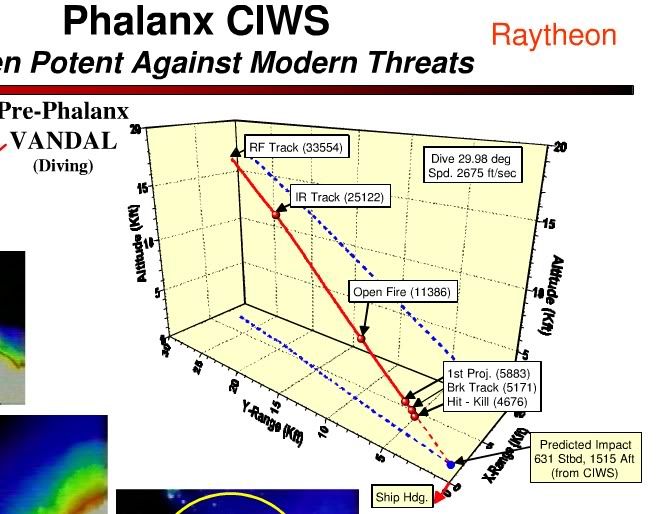Re: The End of the Carrier Age?
They did. Coincidentally there's more than 1 version of the Klub, my favorite being the one I described, but other variants that have the same capability as the CJ-62/Harpoon/Exocet/etc. It has a 400 kg warhead, mach 0.8 speed, and a 300 km range. In regards to AWACs, it all depends on the location of such an incident. An extra 180 km stand-off that the CJ-62 provides is not relevant when it won't get through AEGIS or any similar integrated ship-borne defense systems, it simply won't. Plus, if an AWAC were to be present in our scenario, than it'd be dubious to assume that the CJ-82 won't be detected from beyond it's radar activation range. Simply speaking, if our missile is going to be detected by an off-board sensor suite, i.e., AWACs, than I'd much rather take the missile that has a better chance of surviving the ensuing barrage of Point defense systems, which would be the Klub missile, over the missile that'd be shot out before it begins it attacks, the CJ-62.
Of course, like I said, this all depends on location. If the Carrier in question is <400 km then the CJ-62 would win out simply because the Klub would not be able to reach out that far. However, if the Carrier in question is <220 km, then the Klub wins out, simply because the CJ-62 is inadequate to penetrate a Carrier Battle Group's defensive suite while the Klub is far more likely to do so.
I can do a word-based simulation for you.
Stats of the 3M-54E:
-----------------------
220 km maximum range
200 kg semi-armor piercing HE warhead
Mach 2.9 terminal speed (20 km from target)
3 meter cruise altitude
Stats of the YJ-62
--------------------
400 km maximum range
300 kg semi-armor piercing HE warhead
Mach 0.9 terminal speed (30 km from target)
7 meter cruise altitude
Now, according to the
, (with the AN/SPY-1 antenna being 16 m tall), the 3M-54E can be detected by on-board systems from 23.6 km away, and can be seen by Thermal imagers from 20.4 km away. The CJ-62 can be detected by on-board systems from 27.4 km away, and can be seen by Thermal imagers from 23.7 km away. So, because the Klub can be detected 3.6 km away from it's terminal stage, the Carrier in question will have an extra 13 seconds to engage the Cruise velocity Klub. Once the terminal stage dart separates from the Klub, it accelerates to Mach 2.9 (995 meters per second), which means that it will take 20 seconds for the Klub to finally impact the Carrier. The total time from detection to impact for the Klub s about 34 seconds. The CJ-62 will be detected after it enters it's attack phase, and at Mach 0.9, it will be traveling at about 308 meters per second. The time from detection to impact for the CJ-62 will be about 89 seconds.
The Type 052C destroyer can carry 8 CJ-62s, while the Steregushchy class corvette can carry 6 3M-54E Klubs. If you were to take those two missiles and faced them versus some, off the line Nimitz class carrier, you have to contend with 4 Phalanxes and 24 Seasparrows, at the least. Lets use the Phalanxes for this example, as they are the least capable of the defenses onboard a Carrier and even less capable when compared to other options available in a Carrier Battle Group in general. This is a picture from a Raytheon brochure for the Phalanx:
And I will quote myself here from another forum:
"A couple things to notice. The first is that the Phalanx in question is engaging a MQM-8G Vandal drone which is a variant of the RIM-8 Talos. Next, the drone was about 17,500 ft(5,300 m) in altitude, coming down at an angle of 30 degrees which gave it a velocity of about Mach 2.4 or 815 meters per second. Next, the drone was engaged(detected) at about 33,000 ft(10 km), the Phalanx opened fire at about 11,000 ft(3.3 km) and the target was destroyed at about 4,700 ft(900 meters). From the open firing distance to the destruction distance, it was about 6,300ft(1.9 km). Given that the drone was traveling at Mach 2.4, that makes the the time from firing to destruction out to about 2.3 seconds. In that 2.3 second span, 115-172 rounds could of been expended at the vandal."
So, versus a Mach 2.4 diving target, it took the vandal 2.3 seconds to kill it, and only after it was 900 m from the Phalanx itself. Now, compare the two missiles again. One goes Mach 2.9, the other goes Mach 0.9. The Chinese ship in question only has 2 more CJ-62s than the Russian ship in question, yet the Chinese missile's capability to evade ship-based defense systems is less than half of the Russian missiles in question. Therefore, it seems only logical for me to conclude that because there's a higher probability of success rate for the Russian missiles, it is therefore, superior.
And yes, I do know that I didn't factor AWACs into this situation, it would only mean longer-range engagement of the incoming missiles from the Carrier's side, plus, there's many variables when factoring in an AWAC, such as it's altitude, it's search area, etc, which would of forced me to include the location of this imaginary engagement, which would only complicate the conclusion, which would be a constant in this little word experiment.

